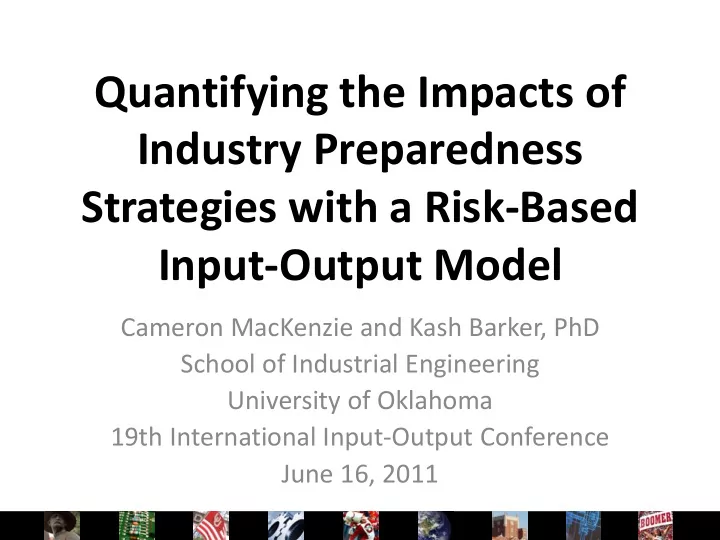

Quantifying the Impacts of Industry Preparedness Strategies with a Risk-Based Input-Output Model Cameron MacKenzie and Kash Barker, PhD School of Industrial Engineering University of Oklahoma 19th International Input-Output Conference June 16, 2011
Risks of global supply chain MacKenzie and Barker 2
What’s new • Production decision for supply shortage • Dynamic model • Interdependent impacts of firm decisions • Illustration of supply shortage • Valuation of different mitigation strategies MacKenzie and Barker 3
Production decision Primary supplier Alternate supplier Inventory on hand suffers disruption at increased cost 1. Reduce production 2. Use inventory 3. Buy from alternate supplier 4. Substitute a different input Constant elasticity Price of substitution Profit production function MacKenzie and Barker 4
Dynamic model Firm’s production Normal production New equilibrium production Reduced production Time MacKenzie and Barker 5
Dynamic model Firm’s production Normal production New equilibrium production Reduced production Time MacKenzie and Barker 6
Dynamic model Firm’s production Normal production New equilibrium production Reduced production Time MacKenzie and Barker 7
Dynamic model Firm’s production Normal production New equilibrium production Reduced production Time MacKenzie and Barker 8
Dynamic model Firm’s production Normal production Reduced production 0 T Time MacKenzie and Barker 9
Sector inoperability Direct impacts from supply shortage Firm’s normal Firm’s degraded production production * y y Industry i ’s 0 , T 0 , T q ( 0 ) inoperability i x i , 0 , T Industry i ’s normal production J.R. Santos and Y.Y. Haimes , 2004. “Modeling the demand reduction input -output (I-O) inoperability due to terrorism of interconnected infrastructures.” Risk Analysis 24 (6): 1437-1451. MacKenzie and Barker 10
Interdependent economic analysis n x 1 vector of Echelon inoperability k 1 * * q A q ( 0 ) I A q ( 0 ) total k 0 1 n x 1 vector of diag x A diag x inoperability for all industries T Q x q 0 , T total Total production losses Normal production for each industry MacKenzie and Barker 11
Illustration
Case study of manufacturing sectors Primary metals Electrical appliances Petroleum Chemical and coal products products MacKenzie and Barker 13
Supply shortage Computer supplies 25% of computer supplies are not delivered MacKenzie and Barker 14
Mitigation strategies Inventory of computer supplies for 10 days Alternate supplier at 2x the price Substitute electrical equipment MacKenzie and Barker 15
Multiregional model • State interdependency matrices from location quotients • 62 industries per state • Commodity flows for 28 industries (Bureau of Transportation Statistics) Outside system MacKenzie and Barker 16
Assumptions of dynamic model Normal production Reduced production 0 10 15 30 35 Number of days MacKenzie and Barker 17
Production losses (millions of Legend dollars) for each strategy 1 No mitigation 2 Inventory Electrical 3 Alternate supplier Primary metals appliances 80 80 4 Substitution 5 All mitigation 60 60 strategies Direct (firm) losses 40 40 Indirect losses 20 20 0 0 1 2 3 4 5 1 2 3 4 5 Petroleum and coal products Chemical products 80 80 60 60 40 40 20 20 0 0 1 2 3 4 5 1 2 3 4 5 MacKenzie and Barker 18
Most impacted Texas industries Production losses by industry (all mitigation strategies) 25 Chemicals Supply shortage in petroleum and coal firm Petroleum 20 and coal Millions of dollars Supply shortage in chemical firm 15 Oil and gas extraction 10 Admin. Rental Misc. 5 Banks and and and professional credit inter- support leasing activities Construction mediation services 0 MacKenzie and Barker 19
Sensitivity on inventory As percentage of total production losses in base case (all mitigation strategies) Amount of inventory 200 Primary metals Percentage of losses Electrical appliances 150 Petroleum and coal Chemicals 100 50 0 0 5 10 15 20 25 30 Number of days MacKenzie and Barker 20
Sensitivity on alternate supplier As percentage of total production losses in base case (all mitigation strategies) Cost of alternate supplier 120 Percentage of losses 100 Primary metals Electrical appliances 80 Petroleum and coal Chemicals 60 1 1.5 2 2.5 3 Ratio of alternate supplier price to primary supplier price MacKenzie and Barker 21
Sensitivity on substitution As percentage of total production losses in base case (all mitigation strategies) Ability to substitute electrical equipment for computers 110 Percentage of losses 100 90 Primary metals Electrical appliances 80 Petroleum and coal Chemicals 70 Substitution ability Low High MacKenzie and Barker 22
Sensitivity on recovery As percentage of total production losses in base case (all mitigation strategies) Primary supplier's speed of recovery Primary metals Percentage of losses 100 Electrical appliances Petroleum and coal Chemicals 50 0 5 10 15 20 25 30 Number of days MacKenzie and Barker 23
Sensitivity on key parameters As percentage of total production losses in base case Cost of alternate supplier Inventory 200 200 100 100 0 0 0 10 20 30 1 1.5 2 2.5 3 Number of days of inventory Ratio of suppliers' prices Recovery of primary supplier Substitution 200 200 100 100 0 0 Low High 5 10 15 20 25 30 Substitution ability Number of days MacKenzie and Barker 24
Conclusions • Model – Incorporates firm decisions into interdependency model – Explains dynamic production where recovery and firm’s mitigation strategies occur simultaneously – Assigns dollar value to each strategy • Case study – Reveals that direct impacts account for 50-80% of production losses – Demonstrates importance of inventory – Is most sensitive to inventory and recovery – Does not incorporate pre-disruption costs of strategies – Does not account for increased demand for competitors MacKenzie and Barker 25
This work was supported by • The U.S. Federal Highway Administration under awards SAFTEA-LU 1934 and SAFTEA-LU 1702 • The National Science Foundation, Division of Civil, Mechanical, and Manufacturing Innovation, under award 0927299 Email: cmackenzie@ou.edu MacKenzie and Barker 26
Recommend
More recommend